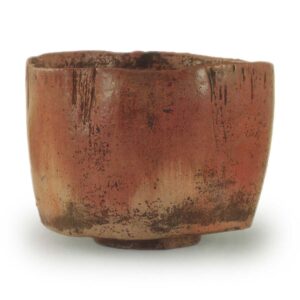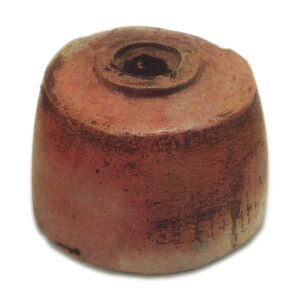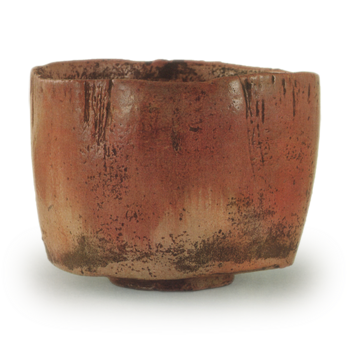

Height: 9.4cm
Diameter: 12.0-12.9cm
Outer diameter of foot ring: 5.7cm
Height of foot ring: 0.6cm
The name “Kaga Koetsu” was not particularly attached to this tea bowl, but it is thought that it became known as the Kaga Koetsu tea bowl because it was made in Kaga, and later became the name of the tea bowl.
This is a unique Koetsu Akaraku tea bowl, and while other tea bowls such as Otome, Yukiho, Shoji and Juo are all made from red clay, this one is made from white clay. Akaraku tea bowls are usually round and friendly in appearance, but this one has a masculine, sharply-angled shape.
The foot ring is quite plain, but the body, from the waist up with its prominent ridges, shows many vertical streaks. The mouth is also quite forceful, with a lot of beveling and changes in height and depth. However, the base of the interior is Koetsu’s characteristic flat bottom shape.
The glaze is made by applying yellow clay on top of white clay and then applying a transparent glaze, so the red coloring is not tinged with purple like that of Otsu Gozen or Seppou, but rather has a yellowish tinge and a bright tone. There is a white hazy variation in part of the rim and part of the area from the base to the waist, and a glaze with a caramel-colored glaze appears in the foot ring.
This tea bowl is the second most scenic of Koetsu’s tea bowls, after Fujiyama.
On the inside of the lid of the inner box, there is an inscription that reads “Red tea bowl, Kaga Koetsu, in the possession of Sosen Soshitsu, Sosen (signature), inherited from Sosen”. This suggests that Sosen Soshitsu, a tea master of the Kaga Maeda clan, owned the tea bowl, but it is also possible that it was owned by Sosen, the son of Sotan, who was a close friend of Koetsu. The author of the inscription, Soken, was the seventh generation of the Chikuso family of the Kyoan school, and he died at the age of 25 in the 18th year of the Kyoho era, so it is thought that this box inscription was written after it came into the possession of the wealthy merchant Kiheiji Fuyuki of Edo.
The author of the inscription on the outer box, “Kouetsu-saku Kaka Tea Bowl”, is the well-known Matsudaira Fumai. After Senso, it was passed on to Nakamura Uchikura-no-suke, a senior official in Kyoto’s Ginza district, and in 1716, when Uchikura-no-suke was ordered to sell off his possessions, many of the famous tea utensils in his possession came to be owned by Kiheiji Ueda of Edo, or Kiheiji of the winter trees, and this tea bowl also passed into the Kiheiji family at that time. Furthermore, during the Kansei era, it was sold to the Edo-based tool dealer Fushimiya and Honsou, along with a set of three hanging scrolls by Sesshu and a Shigaraki Sansetsusui water jar, for 700 ryou (600 ryou in the “Osaki-sama Gidou-dai Otobikomi” document).
Lord Fumai included it in the section on famous tea utensils in his book “Unshu Meibutsu Ki” (Famous Things of Unshu), and it was the first of the Koetsu tea bowls in his possession. He therefore used it often at tea ceremonies, and on December 16th, 1814, he invited Mitsui Hachiroemon and others to a night party with a set of utensils including
1 hanging scroll with the inscription “Rikyu”
1 tea caddy with a bulging lid
one tea bowl by Kaga Koetsu
and other utensils.



